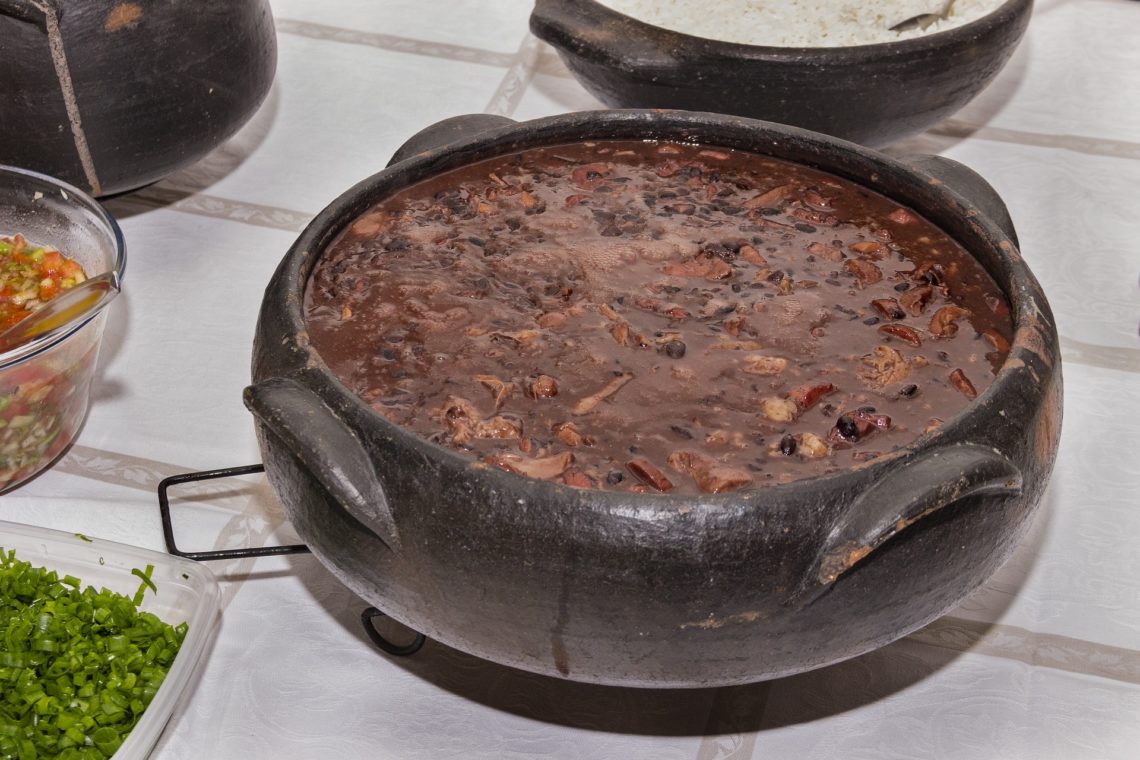Walking around Lisbon I noticed feijoada on many of the menus. That it was so ubiquitous surprised me as I think of it as Brazilian. After all, you don’t see a lot of Mexican food in Spain. At least, I didn’t.
Almost twenty years ago my husband worked at a company so infamous in its mistreatement of its employees that I met people who’d worked there decades ago who still bore scars, and harbored a grudge. It wasn’t long before my husband was ready to quit. His employers may have sensed this because they kept sending him to places like Paris, Athens, and Sao Paulo. At this time I was able to travel with him which is how I was exposed to the Brazilian national dish.
It was a Wednesday and my husband came back to the hotel laughing about this dish they’d been introduced to at lunch. At first they thought it was called “fish water”. After trying the dish in the company cafeteria my husband was less than impressed. Feijoada, a dish of black beans and meat served over rice, reminded him of a lesser version of red beans and rice. A South Louisiana staple he’d grown up with.
That Sunday, at a street cafe in the city, I decided to try feijoada. It is here that we learned what the dish can taste like and why it was the national dish. Feijoada isn’t just beans and rice, it is the stuff of myth and legend. The story goes that feijoada is the creation of enalaved Africans using the offal they were left with, after the masters had taken the choicest bits of meat for themselves, to make a dish so rich and delicious that it is eventually embraced by all Brazilians of every class and color.
In recent years, however, this story has been challenged. Brazilian scholars point out that the type of meats used in the stew were not considered scraps by Europeans of the time. These scholars also point out that the bean stews that were known to Europeans at the time: Codizo in Portugal, cassoulet in France, an array of bean soups and stews in Italy, bear a closer resemblance to the dish than the bean stews of Africa.
As a Black Southerner descended from Africans enslaved in the US (Black American Non-Immigrant or BANI) this reminds me of the Soul Food v Southern food debate. What is the difference between Soul Food and Southern Food? Some argue location, location, location. Others say it’s all Soul Food. According to Adrian Miller, James Beard Award-winning author and food scholar, “Southern food is the mother cuisine that soul food claims heritage to, but soul food is distinct unto itself.”
In many ways Soul Food can be seen as an immigrant cuisine brought to the North by Black Southerners who, like all immigrants, then proceeded to recreate the dishes of the home they left behind with the ingredients of their new home. But it all has Southern roots and those roots are of mixed heritage because Southern food is an amalgamation of many culinary traditions. Foods indigenous to the people of what would become known as the Americas, ingredients from West Africa that arrived in America with enslaved Africans, and European dishes brought by the colonizers.
Which sounds a lot like what the Brazilian scholars are saying about feijoada. So, why is this alteration of the origin story a big deal? It matters because food is much more than sustenance. It’s history and the way we see ourselves. There is the uncomfortable idea that this reshaping of the story essentially strips the dish of its African heritage. In the Smithsonian Magazine Shaylyn Esposito writes of feijoada that “The (enslaved persons) may have been the ones who first started making feijoada, but most likely they were making it for their masters’ palates.” It’s an illustration of how this stripping takes place. In one sentence feijoada goes from a dish created by enslaved Africans to one made by them – a subtle and powerful difference.
I’m not just Southern, I’m from South Louisiana home to Cajun and Creole food. Sidestepping the argument about which is what people are just now starting to recognize the African influence on the cuisine. Growing up those foods were considered French. Maybe a little Spanish. But the contribution of enslaved Africans was left out of the conversation entirely. As Dr. Marcia Chatelain, a Georgetown University professor of history and African-American studies notes this separation of food from its African roots continues in America even now. As Southern food has become more popular, and more high end, the dishes are celebrated but stripped of the economic, social, political and racial realities that created them.
Unlike the US Brazil is very proud of its mixed racial heritage. Most Brazilians will tell you it is more diverse than any other country on the planet. That racially blended heritage is foundational to its national identity. The legend of the development of feijoada, a dish created by slaves and embraced by the population, is a reflection of this. Particularly in face of Brazil’s blatant and pervasive racial inequality. If it is a dish created in the slave quarters does it matter that it was not conceived there?
Despite its ubiquity on menus I did not try feijoada in Lisbon so cannot say how the Portuguese version stands up to its delicious Brazilian counterpart. I will say, despite the problematic way that Portugal deals with its colonizer past, its embrace of feijoada is a closer approximation of its embrace of the people it has colonized. Don’t get me wrong. Like every country touched by colonization Portugal has racial issues unique to those historic endeavors. But a lot of countries, including the US, will gladly accept the food (music, culture,…) while fully rejecting the people. Here in Lisbon, at least as a visitor, I did not feel that was the case.
